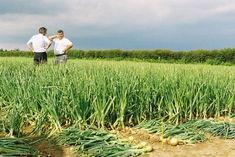
At this year’s NIAB onion set trials 24 varieties, or set sources, were featured from Elsoms, English Set Company (ESC) and Allium and Brassica Supplies (ABS). As well as earlier brown varieties, the trials featured new reds with others in the pipeline.
Change of trial site
Due to water logging of the chosen Essex light land site, this year’s trial moved to A W Mortier Farm, at Aldringham, near to Aldeburgh in Suffolk. Nearly 300mm of rain was recorded at the site since planting, of which 20mm fell the night before the open day last week.
With the last minute switch in trial site, planting was delayed and was slightly later than last year. Although the rainfall has been higher, mean temperatures have not differed greatly to the norm due to the milder nights.
“A few years back, sets tended to be planted at the end of February,” said Bruce Napier. “Now growers are planting from mid to late January. As long as the site is not waterlogged, when the temperatures warm up the sets are ready to go.”
While the trial plots were all planted the same day, two newcomers - ABS 101 and VCS 6003 (ESC) - matured two weeks ahead of the other varieties.
“Consumers are more aware of UK product and prefer to buy British rather than New Zealand imports,” explained Napier. “Early set varieties are helping to eat into imports.”
The season so far
Commenting on the season as a whole, NIAB’s Mike Day said that set crops got off to a good start.
“The roots were well bedded in by the time the dry weather hit,” he said. “In comparison some seeds crops are good while others struggled in April. With the wet weather came the mildew, which has caused problems as growers haven’t been able to get on to the land to spray and fungicides have been washed off.”
Day predicts UK onion crop yields could be down by 10-20 percent, however he estimates the acreage is up by seven percent this year.
As of mid-July, harvesting of over wintered Japanese short day onion crops had begun with some early sets, which tend to be grown on good well drained soil.
brown onions - new early contenders
At this year’s trial, VCS 6003 from ESC proved to be the earliest brown material - a couple of weeks ahead of the standard early varieties Jagro and Forum (Elsoms). While yields are yet to be calculated, in last year’s trial this promising newcomer produced above average yields of thin-skinned uniform round bulbs.
The second earliest maturing set proved to be ABS 101, which is characterised by its fine dark erect foliage. Producing thin skinned round bulbs, its yields last year were below average but still good for an early variety. This year the bulbs look slightly bigger.
Its second year in the trial, VCS 6004 (ESC) has Sturon type foliage, producing thick skinned uniform round bulbs, while VCS 6005 has maturity similar to Jagro. Last year it produced good yields and quality. At the Suffolk trials site it proved to be the plot worst affected by mildew, although apparently this is not the case at the Lincolnshire trial site.
Early/Mid slot
Forum (Elsoms) and Jagro (available from all three set sources) used to be the earliest maturing varieties.
Last year Forum matured three to seven days before Jagro and produced above average yields. Both produce thin-skinned and globe shaped bulbs and are not recommended for long term storage.
With similar maturity to Jagro, Troy (Elsoms) produces above average yields. Fairly thin-skinned, it is prone to sprout in store and therefore needs to be grown for a market.
In comparison, Alpha (ABS) produced above average yields in 2006 and is slow to sprout in store, but can rot.
A newcomer to this early/mid slot is VCS 6164 (ESC). The first year in trial, there is very limited data available at present.
Sturon dominates mid-maturity slot
The standard variety Sturon remains the market leader, accounting for 70 percent plus of set sales. An Advanta seeds variety, sets are available from various sources with the ESC produced sets achieving the highest yielding in 2006.
With similar maturity, Hercules (Elsoms) is slightly lower yielding, producing uniform well-protected globe shaped bulbs. Rumba (ABS) tends to yield better in Lincolnshire trials, with good yields and similar quality to Sturon.
According to Napier the newcomer in the mid-maturity slot, VCS 6162, does not look out of place in the trial although there is little data as yet.
Red onions
The standard variety Red Baron continues to dominate the red sets sector. Two new earlier red set varieties, Red Emperor and Kamal, are poised to help stretch the maturity window.
Its first year in trial, Red Emperor lost some early vigour as the set had already started to sprout before planting. This was due to the planting date being delayed. However Bruce Napier is convinced that Red Emperor is definitely earlier than other reds. Apparently several companies are looking at producing Red Emperor sets.
Kamal from the English Set Company is a hybrid variety. Its second year in set trials, compared to Red Baron it is earlier and produces higher uniformity.
Another hybrid, Hyred from Elsoms, is lower yielding than Red Baron, however it has the advantage of producing very high percentage of single centres.



